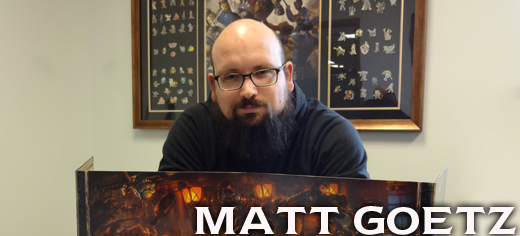
Insider 02-24-2016

I like to steal from my co-workers. I’m not talking about skulking around the office, stealing pens and red Swingline staplers from their desks. What I’m talking about is appropriating content. The epic depictions of brutal combat, monsters, and heroes that appear in another book or Iron Kingdoms-themed game inspire me to create new villains in adventures.
The Undercity is great for this.

To some people, this guy is an Ogrun Brute; to me, he’s Dakkot Korsuk, and he’s going to mess my players up.
I’ve talked before about how well the components from The Undercity work for the Iron Kingdoms Roleplaying Games. But this time, I thought I’d offer a bit of an object lesson into how you can mix-and-match some components.
See, I was jealous of the cool terrain pieces that went into several Undercity scenarios. So, I thought I’d steal them. To that end, we made sure the Catacomb Tiles set used the same color of cobblestones and walls as those in The Undercity. That allows the Game Master to cannibalize a copy of the board game to create some pretty cool additions to a Catacombs adventure. I thought I’d show you a couple of ways I’ve used Undercity components to design complex catacombs.
Bridging Gaps and Blocking Paths
The various fissures are some of my favorite components to mix with the Catacomb Tiles. They help give the sense that a catacomb is in disrepair and crumbling, and they allow me to bridge between two catacomb areas. They also just look dangerous and are narrow enough that the PCs don’t know what’s on the other side until they’ve squeezed through—which sounds like the perfect place to spring a trap or drop a monster on them!

The gate is also a great piece. It’s the perfect width to block off a catacomb’s hallway, forcing the PCs to noisily break it down, pick the lock, or find another way around. Depending on how nefarious the Game Master wants to be, gates are great places to set hazards or traps, since I’ve never met a player who can resist the allure of a locked door.
Trust Falls: Pits and Rubble
The two pits and the collapsed floor tiles (14B, 15B, 16B) are good for Game Masters who want to litter their catacombs with some dangerous pits or impromptu ways to reach lower floors of the ruin—hopefully, the players are willing to jump in to find out which are which!


These gaping holes add an extra dimension to an encounter, particularly if one of the participants has an ability, like Beat Back, to shove opponents to a deadly fall. (As Will Shick once did to no less than five of my Orgoth dread during one playtest game. Keep your eye on Shick; he’s a wily one.)

Another way to give a catacomb encounter greater dimension is to add piles of rubble that litter the floor or the danger of a cave-in. When the PCs trigger a cave-in hazard, I like to toss down a rubble marker to show where it happened. Depending on the situation, the rubble pieces can be small piles of rough terrain, tall stacks that provide cover, or huge mounds that completely block off a passage.

Corpse Tokens and Other Odds and Ends
The Undercity is packed with other little tokens and bits that help me design really interesting spaces. I’m quite fond of the two victim markers. When the PCs take down a significant villain who is Spitting Blood, particularly if they want to try and interrogate him, I’ll swap out the model for one of the victim markers. These markers don’t interfere with the table and provide a clear, albeit grisly, reminder that the clock is ticking and the fallen villain needs some attention if they plan to get any answers out of him.
The staircases and various machines are also a good addition to a well-designed catacomb. I have a standing rule when I use the stairs: red stairs head up, blue stairs head down. If one of the PCs heads downstairs ahead of the rest, I build a smaller map to the side with the red staircase leading back up to where that PC just came from.


When it comes to the machines, I use them for all sorts of different things. As in The Undercity, sometimes they operate gates or unlock passages. Other times, they are necrotite-spewing engines that poison entire regions. They’re pretty versatile and can serve as whatever kind of mechanism the Game Master needs them to be. Need a flooded chamber pumped out? Or a giant steam-powered bridge lowered? Then the boilers and controls are a fantastic solution.

What about you? Have any of you borrowed components from The Undercity for your games of the Iron Kingdoms Roleplaying Game? If so, hop over to the RPG forum and share your creations!

